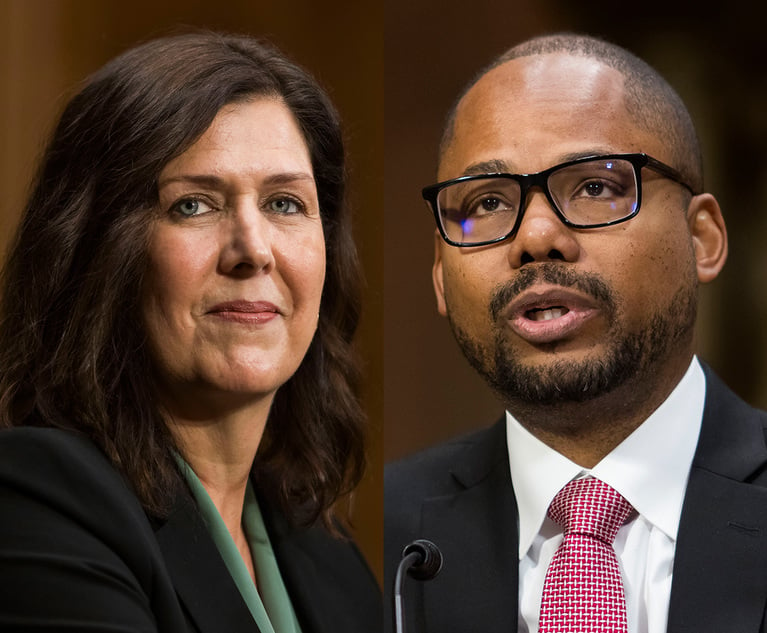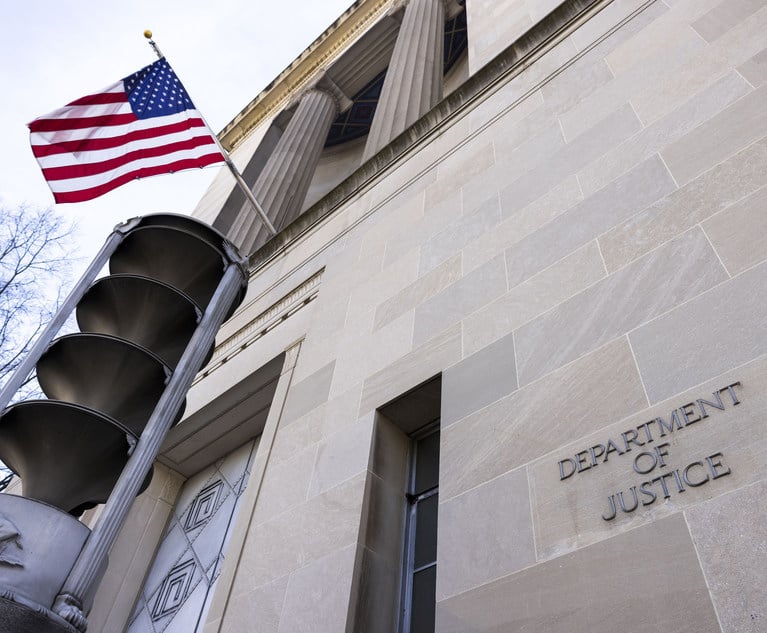 Gavin Newsom, governor of California, speaks during a news conference at the California State Capitol in Sacramento, California, U.S., on Thursday, Feb. 27, 2020. California is monitoring 8,400 people who flew into its airports from Asia and their close contacts for possible infection from the novel coronavirus, Newsom said. Photographer: Patrick Mouzawak/Bloomberg
Gavin Newsom, governor of California, speaks during a news conference at the California State Capitol in Sacramento, California, U.S., on Thursday, Feb. 27, 2020. California is monitoring 8,400 people who flew into its airports from Asia and their close contacts for possible infection from the novel coronavirus, Newsom said. Photographer: Patrick Mouzawak/BloombergThe Cavalry Isn't Coming: Governors and Mayors Take Lead on Coronavirus Pandemic
A Georgetown Law professor outlines how state and local leaders are equipped to act.
March 22, 2020 at 09:54 PM
7 minute read
This month, federalism is getting a workout in a context as old as the nation itself. COVID-19 may be novel, but epidemics have been unwelcome visitors to American states and cities since the start. And under the Tenth Amendment of the U.S. Constitution, the Founders reserved public health emergency powers to the states.
When the coronavirus pandemic emerged, governors knew what they needed to do. But there was not enough trained personnel, equipment, test kits or cash on hand to do it. In the last two weeks we've watched them dust off their emergency public health response notebooks and assess the authorities that they have.
Some, including Gov. Gavin Newsom of California, Gov. Andrew Cuomo of New York and Gov. Mike DeWine of Ohio have taken aggressive measures, showing that in a public health emergency, the governor's political party doesn't dictate their response. Governors are leading in ways the federal government has not.
Last week, at a briefing on the US response to the coronavirus, President Trump announced a national emergency to "unleash the full power of the federal government." What he actually did was make a declaration under the Stafford Act, which authorizes federal aid for disasters "of a magnitude that effective response is beyond the capabilities of the state and local government" unlocking access to the national Emergency Fund for states and locals, as he and past presidents have done to cope with natural disasters like flooding and hurricanes. A federal emergency declaration to respond to a public health crisis is rare, but was part of the response to the West Nile Virus.
The National Guard remains under the control of a state's governor even when activated for a national emergency. That again is a Tenth Amendment guaranteed authority. US Military? Governors can (and should) invite them in, but only for limited peacetime functions, like standing up field hospitals, not for armed assignments, under restrictions first imposed by the post-Civil War Posse Comitatus Act.
People commonly think about the Federal Emergency Management Agency as existing to step in when state and local governments are overwhelmed. That is true to a point. FEMA offers technical recommendations and assistance, logistical support and grant funding. But the current FEMA Strategic Plan makes no reference to public health disasters, with the emphasis being on climate-related disasters and wildfires.
What about those guys we've seen clustered around the microphones at the White House in the last weeks: from the Centers for Disease Control and Prevention, the U.S. Surgeon General, the U.S. Department of Health and Human Services and the Department of Homeland Security? They all advise and support, but they don't direct what happens in the states. A critical function that they can play now is to recommend how to use the infusion of cash from that national emergency declaration.
State public health agencies, which often are underfunded, rely on the CDC and NIH for leadership if a large-scale public health crisis emerges. But under the Trump administration, federal early warning and countermeasure functions have been hobbled by funding cuts, the departure of long-time professionals, and the White House aversion to data collection and the dissemination of bad news. The national strategic stockpile, at the best of times slim, has degraded further through both the last administration and the current one. This week, Trump told governors they should find their own emergency supplies.
What's Next?
The moment calls for aggressive measures; but not unconstitutional ones. Governors will need to consult their public health advisors, and their lawyers, to make sure they play this right. The governors can act collectively through organizations like the National Governors' Association, learning from their peers' best practices and past crises. Mayors also have a critical role. Earlier this month, former New York Mayor Michael Bloomberg's philanthropy announced a network to support mayors in their response to coronavirus. And since viruses don't respect state borders or city limits, metropolitan area response may require coordinated action by multiple jurisdictions and levels of government.
In the midst of all of this, state civil rights watchdogs must remain vigilant. Emergency measures should not be confused with the status quo. And due process guarantees for individuals must be safeguarded. Vulnerable populations are not only the elderly whose health is most at risk, but the undocumented and the incarcerated who at double risk to both their health and human rights. And as Professor Larry Gostin has noted, while quarantine of the exposed well and isolation of the sick is part of governors' public health toolkit, extreme versions like the cordon sanitaire (physical and law enforcement blockade of geographical subdivisions) utilized in Wuhan and now parts of Europe are of dubious constitutionality in the US.
Steps to Take
So what should governors be doing right now? Here are some big things:
- Provide accurate and timely information. This should be sufficiently granular so that parents know what matters for their school-aged children, so the young and old understand the variation of their risk, and so everyone understands why social distancing is a public good.
- Survey the resources. Inventory not only ventilators and critical care beds, but also National Guard personnel, retired physicians and nurses, recently retired army medics, and the enormous reserve of faith- and community-based volunteers who can be mobilized if not for direct care, then for back-office support.
- Utilize executive orders and proclamations. They can help prevent price-gouging, profiteering and other abuses.
- Examine regional compacts and the Emergency Management Assistance Compact so that transfers of critical care patients can be made regionally to hospitals that may have beds available.
- Work with public and private partners to alleviate short-term financial burdens of measures like the temporary end to elective surgery to keep beds open for critical cases.
- Waive regulatory provisions that slow up delivery of urgently needed supplies. Demand that federal regulatory agencies like the U.S. Food and Drug Administration do the same.
- Sign emergency paid sick leave measures that include those on payroll and people in the informal and gig economy. Right now, nobody should feel compelled to show up sick to work.
- Push the federal government for transparency on results of testing and its own planning efforts.
Meryl Chertoff is the executive director of the Georgetown Project on State and Local Government Policy and Law and an adjunct professor of law at Georgetown Law. She has worked at DHS, FEMA and for the New Jersey Governor's Office in its 9/11 response team.
This content has been archived. It is available through our partners, LexisNexis® and Bloomberg Law.
To view this content, please continue to their sites.
Not a Lexis Subscriber?
Subscribe Now
Not a Bloomberg Law Subscriber?
Subscribe Now
NOT FOR REPRINT
© 2024 ALM Global, LLC, All Rights Reserved. Request academic re-use from www.copyright.com. All other uses, submit a request to [email protected]. For more information visit Asset & Logo Licensing.
You Might Like
View All

'Serious Disruptions'?: Federal Courts Brace for Government Shutdown Threat
3 minute read
Government Attorneys Are Flooding the Job Market, But Is There Room in Big Law?
4 minute read
Will Khan Resign? FTC Chair Isn't Saying Whether She'll Stick Around After Giving Up Gavel
Trending Stories
- 1Call for Nominations: Elite Trial Lawyers 2025
- 2Senate Judiciary Dems Release Report on Supreme Court Ethics
- 3Senate Confirms Last 2 of Biden's California Judicial Nominees
- 4Morrison & Foerster Doles Out Year-End and Special Bonuses, Raises Base Compensation for Associates
- 5Tom Girardi to Surrender to Federal Authorities on Jan. 7
Who Got The Work
Michael G. Bongiorno, Andrew Scott Dulberg and Elizabeth E. Driscoll from Wilmer Cutler Pickering Hale and Dorr have stepped in to represent Symbotic Inc., an A.I.-enabled technology platform that focuses on increasing supply chain efficiency, and other defendants in a pending shareholder derivative lawsuit. The case, filed Oct. 2 in Massachusetts District Court by the Brown Law Firm on behalf of Stephen Austen, accuses certain officers and directors of misleading investors in regard to Symbotic's potential for margin growth by failing to disclose that the company was not equipped to timely deploy its systems or manage expenses through project delays. The case, assigned to U.S. District Judge Nathaniel M. Gorton, is 1:24-cv-12522, Austen v. Cohen et al.
Who Got The Work
Edmund Polubinski and Marie Killmond of Davis Polk & Wardwell have entered appearances for data platform software development company MongoDB and other defendants in a pending shareholder derivative lawsuit. The action, filed Oct. 7 in New York Southern District Court by the Brown Law Firm, accuses the company's directors and/or officers of falsely expressing confidence in the company’s restructuring of its sales incentive plan and downplaying the severity of decreases in its upfront commitments. The case is 1:24-cv-07594, Roy v. Ittycheria et al.
Who Got The Work
Amy O. Bruchs and Kurt F. Ellison of Michael Best & Friedrich have entered appearances for Epic Systems Corp. in a pending employment discrimination lawsuit. The suit was filed Sept. 7 in Wisconsin Western District Court by Levine Eisberner LLC and Siri & Glimstad on behalf of a project manager who claims that he was wrongfully terminated after applying for a religious exemption to the defendant's COVID-19 vaccine mandate. The case, assigned to U.S. Magistrate Judge Anita Marie Boor, is 3:24-cv-00630, Secker, Nathan v. Epic Systems Corporation.
Who Got The Work
David X. Sullivan, Thomas J. Finn and Gregory A. Hall from McCarter & English have entered appearances for Sunrun Installation Services in a pending civil rights lawsuit. The complaint was filed Sept. 4 in Connecticut District Court by attorney Robert M. Berke on behalf of former employee George Edward Steins, who was arrested and charged with employing an unregistered home improvement salesperson. The complaint alleges that had Sunrun informed the Connecticut Department of Consumer Protection that the plaintiff's employment had ended in 2017 and that he no longer held Sunrun's home improvement contractor license, he would not have been hit with charges, which were dismissed in May 2024. The case, assigned to U.S. District Judge Jeffrey A. Meyer, is 3:24-cv-01423, Steins v. Sunrun, Inc. et al.
Who Got The Work
Greenberg Traurig shareholder Joshua L. Raskin has entered an appearance for boohoo.com UK Ltd. in a pending patent infringement lawsuit. The suit, filed Sept. 3 in Texas Eastern District Court by Rozier Hardt McDonough on behalf of Alto Dynamics, asserts five patents related to an online shopping platform. The case, assigned to U.S. District Judge Rodney Gilstrap, is 2:24-cv-00719, Alto Dynamics, LLC v. boohoo.com UK Limited.
Featured Firms
Law Offices of Gary Martin Hays & Associates, P.C.
(470) 294-1674
Law Offices of Mark E. Salomone
(857) 444-6468
Smith & Hassler
(713) 739-1250










